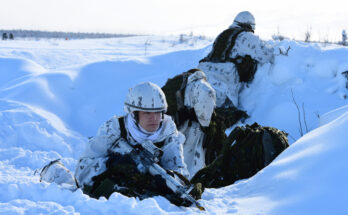
Kh-47M2 Kinzhal Loaded on a MiG-31K. Image – Wikimedia/kremlin.ru
Russia says it is increasing monthly missile production rates. The war in Ukraine is consuming missiles far faster than Moscow had anticipated. Even the large pre-war Russian inventory of tactical strike and theater ballistic missiles cannot meet the demands of this conflict.
Russia needs these missiles to support its offensive operations in Ukraine. Officials in Moscow said Russia is doubling production of precision-guided munitions (PGMs), according to a story in Newsweek. Tactical Missiles Corporation (TMC) is a leading supplier of these systems. Yet achieving an increase in PGM production might come at the expense of other missile programs.
Moscow may try to run its existing missile production lines with additional shifts. To do this, companies need skilled workers (there is already a shortage). Russia could meet this need by moving people off lower-priority production programs and onto others. Of course, these workers will require some retraining. Establishing all-new production lines for PGMs is a longer-term project that cannot produce quick results.
Even if Moscow chooses this path, it still faces a supply problem. Turns out, Russian weapons include a far greater proportion of foreign-made components than once thought. Western sanctions are restricting the supply. So, Moscow must prioritize.
Some Russian surface-to-air missile (SAM) lines are shutting down (or being significantly scaled back) to free up key components. This prioritization could result in a boost in monthly tactical strike and theater ballistic missile production, but it won’t last. Not too far in the future, the monthly production rate will start to drop as the supply of critical parts begins to run out.
Other parts of the Russian defense industry are already feeling the squeeze. The Russian Army is losing tanks in Ukraine at a very high rate. Before the war, there were two active tank production lines in Russia. Recently, one shut down due to a lack of critical components.
How long Russia can sustain a higher missile production rate is anyone’s guess, but it is definitely not indefinitely.
Forecast International’s Missile Forecast provides global long-range forecasts for a wide range of missiles, including air-to-air, surface-to-air, strike, anti-armor, surface-to-surface, anti-ship, and anti-radiation systems, both developmental and in production. Air defense systems such as the Patriot, S-400, ASTER, Sea Ceptor, MEADS, and RBS70 make up the single largest segment of this overall market, fueled in part by the appearance of more advanced combat aircraft and the proliferation of ballistic missiles. For more information, click here.
For more than 35 years, Larry has been involved in research and analytical work for various Forecast International projects. He has contributed to the Airborne Electronics Forecast and was chief editor on the World Aerospace Weekly newsletter. Larry was directly responsible for the creation of World Weapons Review, a biweekly industry market research publication specializing in weapon systems and related material. He was the creator of Unmanned Vehicles Forecast, launched to cover the growing market for civil and military drones, and was involved in the development of the Airborne Retrofit & Modernization Forecast service. He is currently responsible for the Missile Forecast and for FI's two Unmanned Vehicles Forecast services – Airborne Systems and Land & Sea Systems.




